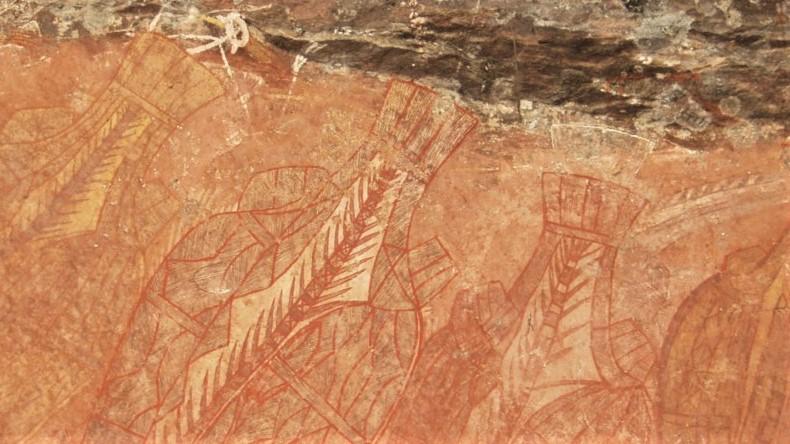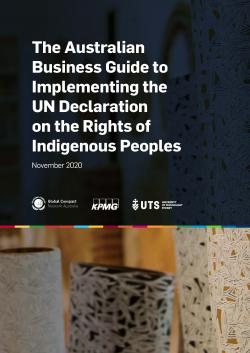A new guide aims to help businesses understand and respect the rights of Indigenous people.

Image: Wikimedia
Gumbaynggirr man, Dr Dean Jarrett, a lecturer in Indigenous Business at UTS Business School, is the lead author of a new report designed to help Australian businesses understand, respect and embed the rights of Indigenous Australians into their daily operations.
The Global Compact Network Australia (GCNA) this week launched The Australian Business Guide to Implementing the UN Declaration on the Rights of Indigenous Peoples, in collaboration with KPMG Australia and the University of Technology Sydney.
The rights of Indigenous peoples have never been more important. With the reinvigoration of the global Black Lives Matter movement, new Closing the Gap targets and the COVID-19 pandemic, a spotlight has once again been shone on the inequalities they face, including Indigenous Australians.
Dr Jarrett says the Guide has the potential to help shape the economic reboot during coming months and years for Indigenous businesses and the buyers of Indigenous goods and services.

“In the context of COVID-19 and the Black Lives Matter movement globally, our nation’s inequitable treatment of Indigenous peoples is being brought to public attention once again, with public rallies, media commentary and government responses such as the refreshed Closing the Gap targets," Dr Jarrett says.
“The guide is about a ‘fair go’ for our businesses and is framed by a human rights-based approach that prioritises people and sustainability now and into the future,” he says.
Designed to complement the global business reference guide for the United Nations Declaration on the Rights of Indigenous Peoples issued in 2013, the Guide has been written specifically for Australian businesses with the GCNA having collaborated with the Indigenous Australian community.
Australia is home to the world’s oldest, continuous living culture. For more than 65,000 years, Indigenous Australians have cared for this country, its land and sea. Businesses must respect this culture.
Kylie Porter, Executive Director of the GCNA says, “COVID-19 is presenting new challenges and applying significant pressure on people and business. But losing focus on upholding the rights of Indigenous persons is not an option.”
“The Guide shows businesses how to engage in meaningful consultation and partnership with Indigenous peoples and outlines how companies can identify and deal with risks to Indigenous persons that often occur during times of crisis.”
“Respecting human rights is the minimum standard expected of businesses, but businesses also have a significant opportunity to demonstrate their respect for human rights and take additional voluntary actions that promote and support human rights.”
The Guide is not intended to provide a one-size fits-all approach but rather outlines the business benefits of greater engagement, key steps to achieve this, and is supported by practical case studies from numerous sectors.
It provides a best practice risk management framework for companies to adopt, and when fully embraced as an expression of Indigenous Peoples rights, goes beyond compliance to empowerment.
Catherine Hunter, Partner Corporate Citizenship KPMG Australia, says society expects businesses to do more than simply take a ‘do no harm’ approach to human rights.
“The global pandemic has raised our awareness of our human connectedness and with this, a greater expectation that businesses will act in the best interests of all stakeholders, including their employees, community and environment.”
“Whether you are at the start of your journey, or more advanced, we hope you find this Guide useful and recommit to engaging in new and respectful ways with Indigenous peoples, their businesses and communities.”
There are already significant opportunities for local businesses to show their commitment to Indigenous engagement. Commitment to Reconciliation Action Plans by more Australian companies will help ensure that the basic tenets of the Guide are achieved.
The plans send a strong and positive signal that workforce policies can be put in place that support cultural diversity and awareness, while also developing business opportunities for Indigenous people. Adopted together, these internationally agreed upon frameworks provide a roadmap to a future in which there is no gap between Indigenous and non-Indigenous Australians.
For Australian businesses, greater collaboration can lead to sustainable economic growth, such as optimising ecosystem services and harnessing local or traditional knowledge. Positive engagement can also contribute to the success of development initiatives through maintaining social licenses to active participation in business ventures as owners, contractors and employees.
The failure to seize the opportunity of stronger relationships and respecting the rights of Indigenous people can mean businesses face greater legal, financial and reputational risk.
Read the Guide here.

